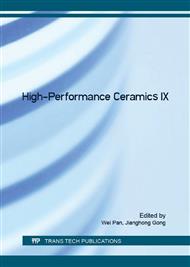p.756
p.761
p.766
p.771
p.777
p.781
p.785
p.789
p.797
Effect of Bias Voltage on Microstructure and Mechanical Properties of CrN Coatings Prepared by Single Target Magnetron Sputtering
Abstract:
CrN coatings were deposited by reactive magnetron sputtering at different substrate bias voltages. The effects of bias voltage on micro-structure and mechanical properties of CrN coatings were studied by scanning electron microscopy, X-ray diffraction, micro-hardness tester and a multi-functional tester for material surface properties, respectively. The results showed that bias voltage had a great influence on morphologies of CrN coatings and CrN coatings presented obvious preferred orientation with the increase of bias voltage. In addition, bias voltages in a certain range can also improve hardness and adhesion of CrN coatings, but higher voltages were not good. In this paper, the adhesion and hardness of CrN coatings presented the trend that a rise first followed by a decline with the ever-increasing bias voltages at the same time, but CrN coating had the superior mechanical properties when the bias voltage was-100 V.
Info:
Periodical:
Pages:
777-780
Citation:
Online since:
July 2016
Authors:
Keywords:
Price:
Сopyright:
© 2016 Trans Tech Publications Ltd. All Rights Reserved
Share:
Citation:


